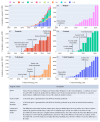Mapping out the scenarios of ocean energy scale-up based on the development of offshore wind
- PMID: 40225910
- PMCID: PMC11993849
- DOI: 10.12688/openreseurope.15906.2
Mapping out the scenarios of ocean energy scale-up based on the development of offshore wind
Abstract
Background: Our oceans remain one of the last untapped large sources of renewable energy. The predictability and reliability of marine energy technologies could contribute significantly to the global energy transition. By 2022, marine energy, and in particular wave and tidal energy have reached a pre-commercial phase in their development.
Methods: This study investigates the potential progression of the wave and tidal energy sector in the next three decades based on the offshore wind sector in the past three decades. Two different models were developed from the yearly capacity increase of offshore wind in Europe and applied to the wave and tidal energy sector.
Results: According to both models, the 40 GW 2050 target for marine energy set by the European Commission in 2020 could be reached if European coastal countries, including countries associated to the EU-27, adopt supportive policies for both technologies immediately. A sensitivity analysis shows further that a small delay right now will have tremendous negative impacts on fulfilling the EU goals and the contribution of marine energy to the energy transition.
Conclusions: The ocean energy sector shows a strong growth potential and is capable of supporting the European and global climate targets substantially by 2050. Lessons learned from the offshore wind sector can help scope and support the growth of marine energy technologies.
Keywords: European targets; Offshore energy; Offshore wind; Policy recommendations; Tidal; Wave.
Copyright: © 2025 Pillet AC et al.
Conflict of interest statement
No competing interests were disclosed.
Figures










References
-
- International Energy Agency: Ocean power. Reference Source
-
- Haces-Fernandez F, Li H, Ramirez D: A layout optimization method based on wave wake preprocessing concept for wave-wind hybrid energy farms. Energy Conv Manag. 2021;244: 114469. 10.1016/j.enconman.2021.114469 - DOI
-
- Azzellino A, Ferrante V, Kofoed JP, et al. : Optimal siting of offshore wind-power combined with wave energy through a marine spatial planning approach. Int J Mar Energy. 2013;3–4:e11–e25. 10.1016/j.ijome.2013.11.008 - DOI
LinkOut - more resources
Full Text Sources
Miscellaneous
